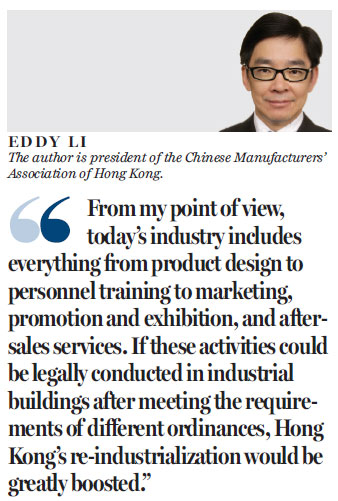New definition of 'industrial use' will help HK's re-industrialization
Updated: 2016-04-22 06:47
By Eddy Li(HK Edition)
|
|||||||
In October, 2009, the government introduced a series of revitalization measures to facilitate the redevelopment of old industrial buildings. The measures came into effect in April, 2010. Through the revitalization policy, the SAR government plans to optimize the use of industrial buildings and provide more floor space to meet increasing demand in both residential and commercial areas. The application deadline, after a mid-term review, was extended for three years from March, 2013. By the end of March, 2016, when the deadline was reached, a total of 248 applications had been submitted, 125 of which were approved.
The six-year program, which allowed industrial building owners to transform their properties into commercial buildings without paying any land premiums, has come to an end. For the reason that "the policy of revitalizing industrial buildings through time-limited measures to optimize the use of old industrial buildings during the economic restructuring period has achieved the expected results", the government will no longer accept any applications of this kind after March 31, 2016.

Indeed, the start of the revitalization policy was outlined with specific conditions: At that time, the vacancy rate of old industrial buildings was high. This is because most of Hong Kong's industrial factories have moved north to the mainland. The government introduced this policy with the purpose of facilitating better use of vacant spaces in old industrial buildings. Recently, however, according to the authorities, the vacancy rate of industrial buildings has declined significantly compared with that in 2009. The vacancy rate in the "industrial" ("I") zone has dropped from 6.5 to 3.5 percent, and that in the "business" ("OU(B)") zones has decreased from 8.4 percent to 6 percent. Rentals for these buildings have increased by 30 percent during the past three years; therefore, it seems a logical and appropriate time for the government to call off this program.
A couple of weeks ago, Secretary for Development Paul Chan wrote in his blog that the percentages of gross floor area for "other uses" (including cultural, creative and arts studios) in "I" and "OU(B)" zones as compared with the figures in 2009 have increased from 2.4 percent to 3.8 percent and from 3.5 percent to 6.2 percent, respectively. This indicates a certain level of demand for floor space for "other uses" in existing industrial buildings. The government, therefore, would consider a further relaxation of restrictions on "non-industrial uses", especially for creative industries.
As an enthusiast of the arts, I fully agree with the government's support for the arts industry. But as a stakeholder, when it comes to optimizing use of industrial buildings, I believe the prerequisite is to clarify the real vacancy rate of these buildings. After all, aside from being used for things like modern drama spaces, art studios, and other art-related places, some industrial buildings are also used, illegally, for divided residential units, private restaurants, bars, and even barbecue sites. Although the government has now legitimatized use of industrial buildings for creative activities, those used for activities that are in violation of the Fire Services Ordinance should not be included in the calculation of vacancy rate.
With the expiration of the revitalization program, it is now the right time for government departments to study the proper uses of old industrial buildings. Firstly and chiefly, the definition of "industrial use", which was developed decades ago, should be modernized. The modern industry sector has been refined and diversified - so should the definition of it. From my point of view, today's industry includes everything from product design to personnel training to marketing, promotion and exhibition, and after-sales services. If these activities could be legally conducted in industrial buildings after meeting the requirements of different ordinances, Hong Kong's re-industrialization would be greatly boosted. As for illegal uses of industrial buildings, for the sake of safety, the authorities should gradually prohibit them. This will help standardize the management of industrial buildings.
(HK Edition 04/22/2016 page9)